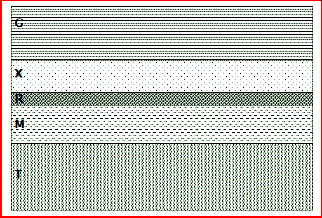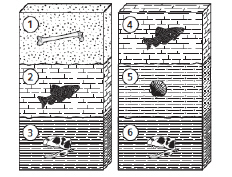Online Assessment
Instructions
1) Type in your first and last name in the
“Name” box in the top-left corner.
2) Next type in your teacher’s name in
the “ID” box.
3) Then type in your school’s name in the
“Email” box.
4) Select the best answer for each question.
5) When you
are finished click the “Grade and Submit” button.
6) The grade will be emailed
to your teacher.
|
|
|
1.
|
NOTE: If your teacher’s last
name is Elliott, then you are doing the wrong assessment.
---This assessment is only for
students of other teachers.
---If your teacher is Mr. Elliott, then please go back to the
website and click on the first assessment link instead. Thanks!
A column of sedimentary rock containing fossils is shown
below.
Geologic Column
(Sedimentary
Rock) | Index
Fossil
Trilobite | | | | |
At layer F shown above
there is an index fossil called a Trilobite. This fossil is from the Cambrian period which occurred
about 500 million years ago. Estimate the relative ages of fossils in layers G, D, and B.
a. | Fossils in layer G are exactly 550 million years old.
Fossils in layer F are about
500 million years old. | b. | Fossils in layer G are younger than 500 million
years.
Fossil layer D and B are older than 500 million years. | c. | Fossils in layer D
and B are about 300 million years old.
Fossils in layer G are about 500 million years
old. | d. | Fossils in layer G are older than 500 million years.
Fossils in layers D and B are
younger than 500 million years. |
|
|
|
2.
|
The diagram below shows
fossils embedded in layers of sedimentary rock
Based on this diagram and
your understanding of the law of superposition, when was fossil one formed?a. | Before fossil 2, but after fossils 3, 4, and 5. | b. | After fossil
2 | c. | After fossil 2, but before fossils 3, 4, and 5 | d. | Before fossils 3, 4,
and 5 |
|
|
|
3.
|
If layer W is 100 million years old and layer Z is 500 million
year old, how old is layer X?a. | between 100 and 500 million years old | b. | there is no way to estimate the age of layer
X | c. | less than 100 million years old | d. | over 500 million years
old |
|
|
|
4.
|
Two fossils that appear to be from the same type of organism are found in two
different layers of rock. The layers of rock are shown below. Which can be determined from the location of the fossils?a. | the predators of the organism | c. | the cause of death for each
organism | b. | the relative age of each organism | d. | the prey of the
organisms |
|
|
|
5.
|
The diagram below shows a column of
sedimentary rock layers.  Layer R contains a well-known index
fossil that is estimated to be 100 million years old. Based on this information and the law of
superposition, you can make the following claim.a. | Layers T and M are older than 100 million years.
Layers X and G are younger than
100 million years. | b. | Layers T and M are younger than 100 million
years.
Layers X and G are older than 100 million years. | c. | Layers T, M, X, and
G are all older than 100 million years. | d. | Layers T, M, X, and G are all younger than 100
million years. |
|
|
|
6.
|
Compare the fossil layers shown
below.
 Which organisms are
most likely to be the same approximate age?a. | 5 and 6 | b. | 3 and 5 | c. | 2 and 4 | d. | 1 and
3 |
|
|
|
7.
|
Two geologic columns are shown below. The columns
are from areas about 1 kilometer apart
Which
sedimentary layers were most likely deposited at the same time?
a. | Layers 2 and 3 | c. | Layers
2 and 6 | b. | Layers 3 and 4 | d. | Layers 1 and
4 |
|
|
|
8.
|
This diagram shows layers of rocks that contain
fossils | | |
Which fossils are MOST likely similar in
age?a. | 4 and 5 | b. | 2 and 3 | c. | 1 and 2 | d. | 4 and
6 |
|
|
|
9.
|
Scientists discovered fossils at two locations, as
shown in the diagram below.
The scientists concluded that the fossils at
these locations were approximately the same age. Which evidence would best support this
conclusion?
a. | Both locations contained the same type of mineral
formations. | b. | Both locations were
above layers containing different types of plant fossils. | c. | Both locations contained a similar number of fossil
types. | d. | Both locations were part of the same layer of sedimentary
rock. |
|
|
|
10.
|
Fossils in Layers of Sedimentary
Rock | | |
The fossil evidence found in these
sedimentary layers reveals that...?a. | organisms with endoskeletons evolved after organisms with
exoskeletons | b. | carnivores evolved from omnivores and herbivores | c. | invertebrates
evolved from vertebrates | d. | land and marine animals evolved together
millions of years ago in the same time period |
|